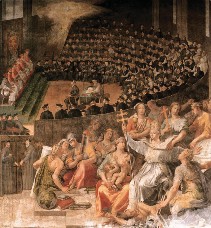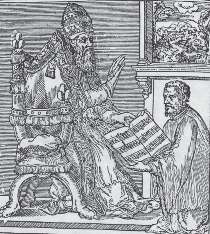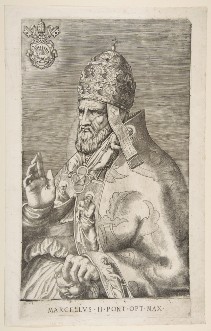11.3: Giovanni da Palestrina - Pope Marcellus Mass
- Page ID
- 92073
\( \newcommand{\vecs}[1]{\overset { \scriptstyle \rightharpoonup} {\mathbf{#1}} } \)
\( \newcommand{\vecd}[1]{\overset{-\!-\!\rightharpoonup}{\vphantom{a}\smash {#1}}} \)
\( \newcommand{\id}{\mathrm{id}}\) \( \newcommand{\Span}{\mathrm{span}}\)
( \newcommand{\kernel}{\mathrm{null}\,}\) \( \newcommand{\range}{\mathrm{range}\,}\)
\( \newcommand{\RealPart}{\mathrm{Re}}\) \( \newcommand{\ImaginaryPart}{\mathrm{Im}}\)
\( \newcommand{\Argument}{\mathrm{Arg}}\) \( \newcommand{\norm}[1]{\| #1 \|}\)
\( \newcommand{\inner}[2]{\langle #1, #2 \rangle}\)
\( \newcommand{\Span}{\mathrm{span}}\)
\( \newcommand{\id}{\mathrm{id}}\)
\( \newcommand{\Span}{\mathrm{span}}\)
\( \newcommand{\kernel}{\mathrm{null}\,}\)
\( \newcommand{\range}{\mathrm{range}\,}\)
\( \newcommand{\RealPart}{\mathrm{Re}}\)
\( \newcommand{\ImaginaryPart}{\mathrm{Im}}\)
\( \newcommand{\Argument}{\mathrm{Arg}}\)
\( \newcommand{\norm}[1]{\| #1 \|}\)
\( \newcommand{\inner}[2]{\langle #1, #2 \rangle}\)
\( \newcommand{\Span}{\mathrm{span}}\) \( \newcommand{\AA}{\unicode[.8,0]{x212B}}\)
\( \newcommand{\vectorA}[1]{\vec{#1}} % arrow\)
\( \newcommand{\vectorAt}[1]{\vec{\text{#1}}} % arrow\)
\( \newcommand{\vectorB}[1]{\overset { \scriptstyle \rightharpoonup} {\mathbf{#1}} } \)
\( \newcommand{\vectorC}[1]{\textbf{#1}} \)
\( \newcommand{\vectorD}[1]{\overrightarrow{#1}} \)
\( \newcommand{\vectorDt}[1]{\overrightarrow{\text{#1}}} \)
\( \newcommand{\vectE}[1]{\overset{-\!-\!\rightharpoonup}{\vphantom{a}\smash{\mathbf {#1}}}} \)
\( \newcommand{\vecs}[1]{\overset { \scriptstyle \rightharpoonup} {\mathbf{#1}} } \)
\( \newcommand{\vecd}[1]{\overset{-\!-\!\rightharpoonup}{\vphantom{a}\smash {#1}}} \)
Next we will consider a famous piece of choral music composed in the late 16th century for use in the Sistine Chapel, which is located within the Vatican in Rome and used by the Pope himself. This piece of music is not only beautiful but historically significant. To understand how it came to be composed and why it has the characteristics that it does, we must take a look at the religious politics of the era.
The Reformation
Beginning in 800, with the foundation of what would later be known as the Holy Roman Empire, the Catholic Church was the dominant religious force in Europe. During the 16th century, however, the Catholic Church began to run into trouble. One by one, factions began to break off, forming new denominations and rejecting the authority of the Pope.
The first sign of defection came in 1517, when Martin Luther, a Catholic priest, posted his 95 theses to the door of a church in Wittenburg, Germany (or so the story goes—it is likely that his writings were in fact disseminated in a less flamboyant manner). Luther’s 95 theses were a list of complaints about the Catholic Church. Some of his objections were to practices that amounted to outright corruption. The most famous of these was the sale of indulgences, whereby priests would forgive the sins of their parishioners in return for money. Luther also objected to the complexity of the Catholic hierarchy, which he saw a preventing Christians from experiencing a direct relationship with God. Finally, he had concerns about the services, which were in Latin (a language that was not understood by most members of the public), and the music, which he worried was overly complex and exclusive.

Luther had no intention of founding a new church. His only desire was to convince the Catholic Church to reform itself. However, he unwittingly began a chain of events that led to the creation of the Lutheran Church—the music of which we will explore in the next section. The English soon followed the Germans in abandoning Catholicism. The Anglican Church was founded in 1534 by King Henry VIII when the Pope refused to annul his marriage to Catherine of Aragon. And in Switzerland, the Calvinists were defecting from the Catholic Church during this same period.
All of this constituted a crisis for the Catholic Church, which saw the first major challenge to its authority in Europe. To address the crisis, the Pope convened an ecumenical council of high-ranking church officials to reform Catholic doctrine. The Council of Trent was held between 1545 and 1563. It debated a number of issues, and in fact adopted some of the reforms first suggested by Luther.
In 1562, the Council turned its attention to music. It determined that music for worship had come to inappropriately resemble that intended for entertainment. To correct this, the Council banned the use of musical instruments, which were associated with dancing and secular song and were therefore considered inappropriate for worship. Instruments, however, were not the only concern. Church composers had developed the habit of including popular tunes in their music, usually to demonstrate how clever they were at reworking preexisting musical material into something new. Their compositions were also becoming virtuosic and extravagant, and the Council was concerned that the focus of church music was on fancy singing, not the meaning of the text.
The Council was particularly critical of polyphonic music, in which each vocal part has an independent melody. In such compositions, the sopranos, altos, tenors, and basses each sing the words of the text at different times, which can make those words almost impossible to understand. Such music is beautiful, but it was perceived to be undermining the goals of the church service.
The Council of Trent briefly considered banning polyphonic music altogether, but ultimately did not, instead issuing strict rules about how such music must be composed. They required that music for the church be sober and restrained, avoiding the showy excesses that were characteristic of music for entertainment, and that the text always be comprehensible. They encouraged styles that were syllabic, meaning that each pitch corresponds to a single syllable of text, and homorhythmic, meaning that all of the voices move in rhythm together, each singing the same text at the same time.

Luckily for the Catholic Church, a composer was ready to take on the challenge of creating compelling music that met their requirements. Giovanni da Palestrina (1525- 1594) spent his entire life in the employment of the Catholic Church. He served as organist, singer, and choir director at a variety of churches in Rome, including St. Peter’s basilica, the largest church in the world. It is worth noting that women were prohibited from singing in the choir at St. Peter’s. Instead, the high vocal parts were performed by boys, by men who sang in a high falsetto range, or by men known as castrati due to the fact that they had been castrated before puberty with the result that they retained voices in the soprano range. In total, Palestrina served ten Popes—a testament to the longevity and impact of his career.
Palestrina and his Music
Palestrina was an advocate of a musical style known as the ars perfecta, or “perfect art.” Members of this school of composition believed, first and foremost, that music—like human beings—could be perfected. They sought to develop and formalize a style that was rational and aesthetically pleasing. Palestrina, after all, lived and worked at the height of the Italian Renaissance, a period during which the sciences and arts both flourished as intellectuals revived the values of ancient Greek and Roman civilizations. Adherents to the ars perfecta developed a set of rules for composers to follow. The resulting music was calm, free of dissonance, and fairly predictable. It radiated a sense of self-control and rationality. It also all sounded pretty much the same. Perfection, after all, cannot be improved upon.


Palestrina’s enormous body of music is considered to exemplify the peak of achievement in the ars perfecta style. His compositions were particularly influential due to the invention in 1501 of a technique for printing music. Rome was home to one of the first music publication firms, meaning that Palestrina’s compositions could easily be published and distributed across Europe. Palestrina was enormously productive. He wrote over four hundred motets—stand- alone choral pieces with Latin texts that are intended for use during church services. He also created at least 104 settings of the Mass Ordinary, the most famous of which we will examine here.
The Mass Ordinary contains all of the words that are spoken or sung at every Catholic Mass, which today we can think of as the typical Sunday morning service. The entire text of the service, including the parts that change from day to day, is termed the liturgy. The Mass Ordinary, like the rest of the service, is principally in Latin, and it contains five parts: Kyrie, Gloria, Credo, Sanctus, and Agnus Dei. Each part contains a text that is considered central to the Catholic faith, and which parishioners must speak, sing, or at least hear every time they attend a service.
Pope Marcellus Mass
We will examine the Kyrie and Credo from Palestrina’s Pope Marcellus Mass. Out of Palestrina’s many Masses, this one is the most closely associated with the Council of Trent and its musical reforms. Indeed, it is fabled that the Council decided not to ban polyphony after hearing this Mass, although most historians doubt the truth of this story. However, this Mass was certainly composed with the musical values of the Reformation in mind, and it satisfied the Council’s requirements.
It is not certain when Palestrina composed this Mass, but it is named for Pope Marcellus II, who reigned for only twenty-two days in 1555. Marcellus’s brief papacy happened to span Holy Week, the most sacred period in the Catholic calendar. Holy Week encompasses the seven days leading up to Easter. The most austere of these is Good Friday, on which day the faithful remember Jesus’s crucifixion. Following the 1555 Good Friday service in the Sistine Chapel, Pope Marcellus berated the choir for singing music that he found inappropriate given the seriousness of the occasion. Apparently they had chosen music that was complex and virtuosic, while the Pope would have preferred something simple and modest.

This Mass, therefore, was a direct response to the Pope’s complaint, but also a more general response to concerns that were later expressed by the Council of Trent. By the time it was published in 1567, it was a model for Catholic composers everywhere. With the Pope Marcellus Mass, Palestrina satisfied the new requirements of the Catholic Church without abandoning his musical values. His Mass was beautiful and expressive, but also modest and clear. He has succeeded in producing art that served the requirements of worship.
To see how this music worked, we will consider the Kyrie and the Credo. These are the most disparate movements of the Mass. The Kyrie has the shortest text: It translates in its entirety to “Christ have mercy, Lord have mercy, Christ have mercy.” The text is also unusual because it is in Greek, not Latin. The Credo has the longest text, for it details all of the core Catholic beliefs. This text is also known as the Nicene Creed, for it was adopted by the First Council of Nicea in 325. In the context of a musical setting, however, this movement is always termed the Credo. The Latin verb “credo,” which opens the text, means “I believe.” The Credo goes on to summarize the story of Christ and state the essential tenets of the faith. The current English version of the Nicene Creed as used by the Catholic Church reads as follows:
I believe in one God, the Father almighty,
maker of heaven and earth,
of all things visible and invisible.
I believe in one Lord Jesus Christ, the Only Begotten Son of God, born of the Father before all ages. God from God, Light from Light, true God from true God,
begotten, not made, consubstantial with the Father; through him all things were made.
For us men and for our salvation he came down from heaven,
and by the Holy Spirit was incarnate of the Virgin Mary, and became man.
For our sake he was crucified under Pontius Pilate, he suffered death and was buried,
and rose again on the third day
in accordance with the Scriptures.
He ascended into heaven
and is seated at the right hand of the Father.
He will come again in glory
to judge the living and the dead and his kingdom will have no end.
I believe in the Holy Spirit, the Lord, the giver of life, who proceeds from the Father and the Son,
who with the Father and the Son is adored and glorified, who has spoken through the prophets.
I believe in one, holy, catholic and apostolic Church. I confess one Baptism for the forgiveness of sins and I look forward to the resurrection of the dead and the life of the world to come. Amen.
Kyrie
For his setting of the Kyrie, Palestrina did not take particular concern with the clarity of the text. The reason is evident enough: The text is very brief, and it is instantly recognizable by its first word, which appears nowhere else in the liturgy. In keeping with the three-part structure of the text, Palestrina uses a ternary musical structure. He repeats the short text many times within each section, such that the listener hears the Greek words dozens of times.
|
Time |
Form |
What to listen for |
|---|---|---|
|
0’00” |
“Lord have mercy” |
Each of the six parts enters independently; it is impossible to say which has the melody |
|
1’17” |
“Christ have mercy” |
This section begins with the soprano and bass in homorhythm, but soon becomes polyphonic |
|
2’37” |
“Lord hav emercy” |
This section has the same texture as the first “Lord have mercy,” but the musical contents are different |
The nature of the text allows Palestrina to do two things with his music that were otherwise frowned upon by church authorities. First, his Kyrie is highly imitative, each vocal part entering independently. There are six vocal parts, meaning that the texture quickly becomes dense. First, we hear the altos. Next, the highest sopranos, followed by the lowest basses. Within half a minute, everyone is singing. No single part has the melody. Instead, as is typical of polyphonic music, every part is equally important, and melodic fragments are passed around. This also means that the text does not line up between vocal parts. Second, his vocal lines are melismatic, meaning that many notes are sung on a single syllable of text.
All the same, Palestrina is careful not to show off. The music is noble and stately. The melodies are modest and restrained, while the harmonies move slowly and deliberately. The movement has a single, introspective mood. Palestrina aims to create an atmosphere in which churchgoers can ponder the meaning of the words and prepare for worship.
Credo
The Credo is quite different. To begin with, although the Credo text is about thirty times as long as the Kyrie text, the Credo movement is only about twice as long as the Kyrie. This is because Palestrina does not repeat text and does not draw out words using melismas. Instead, he focuses on moving through the text from beginning to end with the maximum of clarity.
Palestrina achieves this clarity in several ways. First, he seldom uses the entire choir, instead limiting the texture to three or four vocal parts. Second, he uses a homophonic texture in which all of the parts sing the same words at the same time. Finally, he avoids melismas, using them only at the ends of phrases once the meaning has already been communicated.
|
Time |
Text |
What to listen for |
|---|---|---|
|
0’00” |
“I believe in one God ...” |
The opening line is chanted by a solo male voice |
|
0’07” |
“... the Father almighty ...” |
We seldom hear all six voice parts at the same time; instead, groups of three to five voice parts take turns singing phrases in homorhythm |
|
2’31” |
“... and by the Holy Spirit ...” |
The note values lengthen and the rhythmic complexity lessens |
|
3’27” |
“For our sake he was crucified...” |
The texture is reduced to four voices; at first, we hear only the low parts |
|
5’11” |
“I believe in the Holy Spirit. . .” |
The texture expands to six voices; this passage is sprinkled with melismas |
|
7’53” |
“Amen” |
The texture becomes increasingly polyphonic |
The Credo contains more musical diversity than the Kyrie. Palestrina divides it into four sections. The first includes the opening text, the second begins with Christ’s incarnation, and the third describes his crucifixion, resurrection, and ascension. The final section lists the core Catholic beliefs. Because the third section contains the text most essential to Christianity, it receives the most serious treatment. Palestrina reduces his choir to four parts and uses long note values for the passage about Christ’s burial, followed by more rapid rhythms to symbolize his return to life.
Palestrina’s Pope Marcellus Mass provides an excellent example of how the values of the Christian church influenced the development of music. Palestrina’s Latin-texted compositions are frequently performed by choirs today, and they are widely admired for their elegance and beauty. However, Palestrina might never have produced music in quite this style were it not for pressure from his employers.


